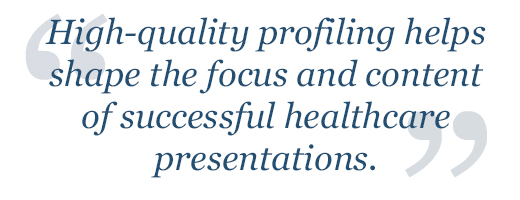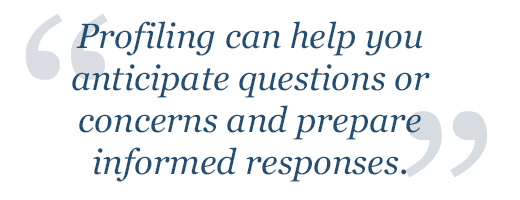Effective speakers and presenters know the value of audience analysis, but for drug, biotech, and device development teams preparing for an Advisory Committee meeting, the incorporation of reliable and thorough profiling of Committee Members takes on special importance.
Profiling provides an understanding of an individual as well as his or her relationships and sphere of influence. Through integrating that insight, the team prepares itself to be not only understood but persuasive. High-quality profiling helps shape the focus and content of successful healthcare presentations and Q&A sessions.
When possible, team members should attend an Advisory Committee meeting in person to see how the meeting is conducted and how members behave. Notice the routines and conventions of an AdComm, including room arrangement. Look at individual and group interaction for insight into how the dynamic unfolds, not only between the sponsor and Committee but also within the Committee itself and between the Committee and FDA.

If it's not possible to attend a meeting of the Advisory Committee that your team will address, members should watch a live or recorded webcast. While not all AdComms are broadcast as webcasts, many are. If they take place at FDA's White Oak facility, they can be accessed through the home page of the Advisory Committee.
It's also revealing to conduct a media audit that includes interviews, public speeches, and educational talks given by AdComm members. These materials acquaint the team not only with the manner and style of members but provide additional information about concerns and expertise.
The team should also review its own experiences and relationships for insight into AdComm members. Has anyone on the team attended an AdComm meeting in which current Committee members have participated? Find out and then share the information. Canvass colleagues and KOLs for whatever knowledge they might provide.
Scour transcripts of AdComm meetings held to discuss approvals or compose guidelines in your therapeutic area. Pay special attention to issues similar to those your team and product may face.
While the most recent transcripts may give you the clearest picture of current members' personalities, contribution styles, and primary concerns or prevailing issues, older ones may provide a perspective on issues useful to your team as it constructs documents, presentations, and responses.
And, since current members have often previously served as Temporary Voting Members, older transcripts may contain valuable information on the most newly-appointed of the AdComm members with whom your team will meet. Current and past years of Committee meeting materials are accessible from this page of the FDA website.
Analyze voting records and the rationale each member provides for his or her vote. Just as important are the comments members make during discussion, each one an indication of how the member receives and processes messages and supporting data. Look for patterns and determine their significance.
Look for patterns in Q&A sessions also. Some members may invariably ask questions about non-inferiority or PROs, concomitant therapies or population demographics, physician education or definitions of endpoints. Know their hot spots.
In addition, check the publication records of AdComm members; be especially alert to the relationships and common interests suggested by listed co-authors and their affiliations.
Although all profiling requires research, delving deeper into some areas will help build your understanding of a member's background and likely perspective.
One of these areas is educational history – degrees attained, institutions attended, fellowships completed. Note faculty whom a member lists as a mentor or supervisor as well as specific researchers mentioned.
Another area to explore is the member's professional life. Determine his or her faculty standing and interests, association membership, and officer or board status. Check participation on steering or practice guideline committees as well as activity in Continuing Medical Education courses. Locate descriptions of members' medical practice and positions filled in clinical trials.
Finally, if you didn't conduct a media audit as part of the observation step, complete one in this step.
In addition to profiling regular AdComm members, the team may find it useful to profile other individuals or groups. In the case of Temporary Voting Members, profiling is essential; what makes it a special case is the short time in which it must be accomplished.
Temporary Voting Members
Persons appointed Temporary Voting Members have often served previously as regular or temporary members or may be prospective Committee members. At times they are selected to take the place of a regular member who cannot attend the meeting, but they are usually chosen for expertise the FDA believes is needed in order for the Committee to properly examine risk/benefit of a particular product.
For products reviewed by the Center for Drug Evaluation and Research (CDER), the FDA publishes a Draft Committee Roster 48 hours before the scheduled start date of the meeting; it lists the names of Temporary Voting Members as well as regular Members expected to attend. Profilers must work quickly to make needed information available for team review; a short turnaround provides the team an opportunity to make late changes to its Core Presentation and Q&A responses.

Chair
Although usually a regular member of the Advisory Committee, the Chair is sometimes a Temporary Voting Member. In either case, note how closely the Chair follows procedure and how objectively he or she conducts the meeting. While that information will be useful as you plan the Core Presentation, it will be crucial to preparing Q&A responses.
FDA Representatives
A team may sometimes find it beneficial to profile participating FDA officials in order to garner insight into the nature of their presentations and responses, levels of formality, and/or their attitudes or behaviors toward committee members and sponsors.
Open Public Hearing Speakers
While some speakers are individuals who attend to explain their experience with a condition or treatment, many will speak as representatives of associations or groups. Know which organizations have a stake in the outcome of the meeting and what their platform is. Proactively address their concerns as appropriate in the presentation and responses.
By knowing the parameters of members' expertise, the issues about which they are most passionate, and how their histories reach into the present, the team can construct rhetorically effective ways of communicating messages and support. It can anticipate questions or concerns and prepare informed responses. It can shape the Core Presentation in ways that acknowledge relationships among members, their institutions, their research, and their practice. The team can become attuned to the nuances of speech and body language that may signal offense, agreement, or simple curiosity.
While we people are not unerringly predictable, we all have patterns of behavior and belief that we tend to follow. Through profiling, a team can know and analyze these patterns, making them a part of the foundation on which to base the persuasive communication of messages and responses to AdComm participants.





